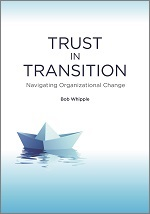ATD Blog
Trust in Transition By Bob Whipple
Tue Jul 22 2014

My new book, Trust in Transition: Navigating Organizational Change, will launch on August 18, 2014, by ASTD Press. The book is about how organizations must do a better job of preserving and enhancing trust when they go through such changes as reorganizations, mergers, acquisitions, or other restructurings.
There are numerous books on managing change, and many books and articles on mergers and acquisitions. Trust in Transition is unique in that it focuses on the actions and behaviors needed to maintain the vital trust between people and organizational layers during the process of change.
Linking trust to performance
A link between trust and organizational performance has been demonstrated in numerous studies. The correlation is strong, and the leverage offered by high trust is impressive. Most studies show a two to five times productivity benefit in high trust groups over low trust groups. Can you name any other single factor that can offer a 200 percent improvement in productivity?
When organizations contemplate changes, the manner in which the effort is planned, organized, announced, managed, and led has everything to do with the impact on trust. Unfortunately, in the vast majority of cases, the changes end up having a profound negative impact on the culture—just when trust is needed the most.
As you can expect, this condition undermines the change effort. More important, it leads to a documented dismal track record of some 80 percent of transitions failing to live up to expectations.
Thankfully, organizations can avoid failure by taking steps to act differently and prevent problems from occurring right from the start of a change process. Indeed, the old adage of "an ounce of prevention is worth a pound of cure" holds true. If some changes in mindset can be accomplished from the earliest plans for a change, the ability to retain or even grow trust during change is possible.
Breaking the cycle
Trust in Transition is about how to break the cycle of change failure by focusing as much effort on the cultural integration as on the mechanical parts of the change process.
Regrettably, many leaders have had professional training in the MBA schools that emphasizes only the mechanical aspects of the change process such as negotiation, due diligence, financial valuation, or legal implications. These subjects are critical in transitions, but they should not squeeze out the considerations of how to get people to work well together during and after the transition.
The focus on the financial and legal implications of change are forced to center stage, and the fragile culture of trust between people in the organization ends up back in the wings. That is a problem because the end result is a change effort that works well on paper, but often fails to meet expectations in the real world.
Moving forward
Trust in Transition contains dozens of areas where leaders unwittingly make errors in judgment all along the way that undermine change. By following a parallel path that works just as hard on the culture as the process or mechanics of a deal, leaders can greatly improve the odds of success.
Over the next few months, I will provide a series of posts that examine different aspects of the change process to suggest pragmatic antidotes to common problems. The book site will also offer access to a set of videos that enhance several of these key points.
Investing more leadership attention to the culture early in the change process will have a profound positive impact on the success rate. I hope you find the tips I offer in the book and future articles to be helpful at preserving trust in your organization—nothing could be more vital for your ultimate success.
You've Reached ATD Member-only Content
Become an ATD member to continue
Already a member?Sign In
